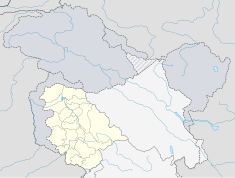Baglihar Dam
| Baglihar Dam | |
|---|---|
 |
|
|
Location of Baglihar Dam in India Jammu and Kashmir#India
|
|
| Country | India |
| Location | Jammu and Kashmir |
| Coordinates | 33°09′43″N 75°19′40″E / 33.16194°N 75.32778°ECoordinates: 33°09′43″N 75°19′40″E / 33.16194°N 75.32778°E |
| Construction began | 1999 |
| Opening date | 2008 |
| Dam and spillways | |
| Type of dam | Gravity |
| Impounds | Chenab River |
| Height | 144 m (472 ft) |
| Length | 317 m (1,040 ft) |
| Elevation at crest | 844.5 m (2,771 ft) |
| Dam volume | 1,800,000 m3 (63,566,400 cu ft) |
| Spillway capacity | 16,500 m3/s (582,692 cu ft/s) |
| Reservoir | |
| Active capacity | 15,000,000 m3 (12,161 acre·ft) |
| Inactive capacity | 37,000,000 m3 (29,996 acre·ft) |
| Power station | |
| Commission date | Stage I: 2005 Stage II: 2008 |
| Hydraulic head | 130 m (427 ft) (gross) |
| Turbines | Stage I: 3 x 150 MW Francis-type Stage II: 3 x 150 MW Francis-type |
| Installed capacity | Stage I: 450 MW Stage II: 450 MW Total: 900 MW |
Baglihar Dam (Hindi: बगलिहार बाँध Baglihār Bāndh), also known as Baglihar Hydroelectric Power Project, is a run-of-the-river power project on the Chenab River in the southern Doda district of the Indian state of Jammu and Kashmir. This project was conceived in 1992, approved in 1996 and construction began in 1999. The project is estimated to cost USD $1 billion. The first phase of the Baglihar Dam was completed in 2004. With the completion of the second phase on 10 October 2008, Prime Minister Manmohan Singh of India dedicated the 900-MW Baglihar hydroelectric power project to the nation.
After construction began in 1999, Pakistan claimed that design parameters of Baglihar project violated the Indus Water Treaty (full text) of 1960. The treaty provided India with exclusive control over three eastern rivers, Near Beacon tunnel while granting Pakistan exclusive to three western rivers, including Chenab River. However it contained provisions for India to establish run-of-the-river power projects with limited reservoir capacity and flow control needed for feasible power generation. Availing this provision India established several run-of-the-river projects, with Pakistan objecting to these. Also in the case of the Baglihar and Kishanganga Hydroelectric Plants, Pakistan claimed that some design parameters were too lax than were needed for feasible power generation and provided India with excessive ability to accelerate, decelerate or block flow of the river, thus giving India a strategic leverage in times of political tension or war.
During 1999-2004 India and Pakistan held several rounds of talks on the design of projects, but could not reach an agreement. After failure of talks on January 18, 2005, Pakistan raised six objections to the World Bank, a broker and signatory of Indus Water Treaty. In April 2005 the World Bank determined the Pakistani claim as a ‘Difference’, a classification between the less serious ‘Question’ and more serious ‘Dispute’, and in May 2005 appointed Professor Raymond Lafitte, a Swiss civil engineer, to adjudicate the difference.
...
Wikipedia


